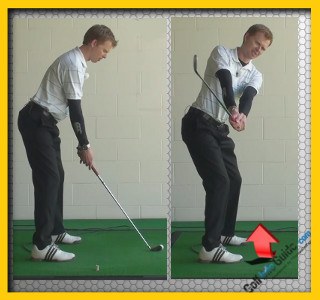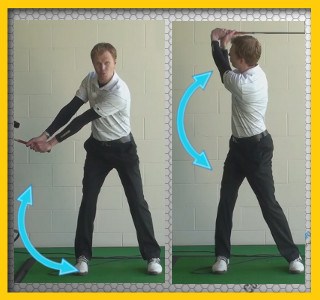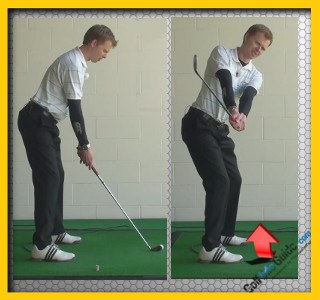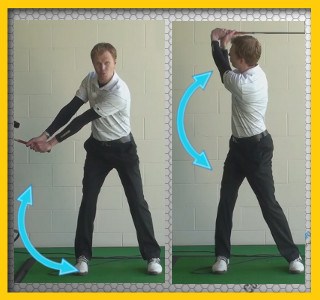
Who Is He?
When Adam Scott lost The 2012 British Open to Ernie Els, having held a four shot lead with four holes to play, many people questioned whether this showed a weakness in his ability to perform under pressure in a major championship, and suggested that this may have been his only chance to win one of golf's big four tournaments. However, Adam Scott proved the doubters wrong by capturing The 2013 Masters tournament, having defeated Angel Cabrera in a play off.
What He Does

There was a time in the 90s when Adam Scott's golf swing looked more like Tiger Woods' golf swing than Tiger's own swing. During this period, both players worked with Butch Harmon to develop their super wide and super athletic movements. Some say that even to this day, Adam Scott has the swing that Tiger wishes he still had.
What Can You Learn?
Adam Scott is an incredible athlete and he uses his superb physique and flexibility to great effect. From a super strong set up, Adam Scott coils his upper body and keeps his leading left arm in a very wide and extended takeaway movement. The width in Scott's swing continues all the way to the top of the backswing position. From here, he is massively coiled up and ready to deliver supreme club head speed towards the back of the golf ball. In order to do this on a consistent basis, Scott has to work on his flawless balance in the finish position.

What Should You Avoid?
One of the only real weaknesses in Adam Scott's game is his reliance on the broom handle putter. Adam Scott currently uses one of the longest putters on tour to good effect. However, he will have to make some sweeping changes to this part of his game as the new rules coming into play in 2016 will outlaw his anchored style of putting stroke. It will be interesting to see if Adam Scott can maintain his status as one of the world's best players if he is forced to use a standard length club, without an anchoring point.

Adam Scott Pro Golfer Swing Sequence
By any measure, Adam Scott is among the very best golfers in the world. He is a past champion of The Masters, he has won numerous top events while playing against world-class competition, and he has one of the prettiest swings on Tour. While there is more to playing great golf than just making a nice looking swing, Scott has long been known for his picture perfect technique. It is not a realistic goal to attempt to copy the swing of Adam Scott for your own purposes, but there is certainly a lot you can learn from studying his swing sequence. Even if you only take one or two small points from his swing for application in your own game, you could find yourself quickly improved thanks to what you have learned.
One of the things that will stand out to you immediately when you review Adam Scott's swing is the ideal positions that he puts himself in from address all the way through to the finish. Even among the top players in the world, this skill is relatively rare. Many top players have some kind of unique move that they make at one point or another in order to deliver the club to the ball. That really isn't the case with Scott. Instead, his swing looks like it is directly from the 'Golf 101' manual, as he checks off one good position after another until he is finished. It would be hard to pick out anything that is specifically wrong with this swing, which is why he consistently is among the best ball strikers in the game. When his putter is working, Adam Scott is incredibly consistent, and incredibly difficult to beat.
Remember, as you read through the content below, you are not trying to exactly replicate Adam Scott's swing. That task would be essentially impossible anyway, and it would only lead to frustration and disappointing results. Instead, you are looking for ways that you can take bits and pieces from his swing in order to improve your own. You already have a golf swing in place, for better or worse, so you aren't starting from scratch. The goal is to embrace the swing you are starting with, and then make changes to it using someone like Adam Scott as a model. Perhaps you need to improve on your takeaway, or your transition, or maybe even your follow through - look to how Scott completes these parts of the swing and then practice accordingly. The results are not going to be immediate, but they can be powerful once you have put in the necessary time on the practice range.
All of the instruction below is based on a right handed golfer (like Adam Scott). If you happen to play left handed, please take a moment to reverse the directions as necessary.

The Takeaway
A good golf swing is always built on a good takeaway. The movements that you make within the first few inches of the backswing play a large role in what is going to happen the rest of the way through the shot. If your takeaway is fundamentally sound, you should have very little trouble striking the ball cleanly when you come back down to impact. On the other hand, if you are making some kind of mistake during this initial phase of the swing, there will be all sorts of trouble to follow. It might not be particularly exciting to work on your takeaway when you head out to the driving range, but the work that you do on this important part of the swing will pay off big time in the end.
As you might expect, the takeaway that Adam Scott uses in his swing is picture perfect. If you watch a slow motion video of his takeaway, you will notice that it looks like nothing really happens - which is ideal. His turn away from the ball is extremely simple and straightforward, which allows him to stay on plane and in position for a great strike. If you would like to move your takeaway in this simple direction, work on the tips provided below.
- Chin up. Believe it or not, one of the biggest keys to making a great takeaway is keeping your chin up away from your chest at address. You need room to turn away from the ball with your upper body, and you aren't going to have that room if your chin is tucked down into your chest. Maintain a nice posture by keeping your chin up and then simply turn your left shoulder under the chin and away from the target. You want to keep your eyes down on the ball, of course, but that chin should be up in order to permit a full turn.
- Slow at first. One of the worst things that you can do in your swing is rip the club back away from the ball in a rush. You want to use your takeaway to set up an even tempo for the rest of the swing, so go slow at first and gradually build speed throughout the rest of the backswing. There is no reason to hurry after all - the ball isn't going anywhere until you hit it. On the range, work on using a slow takeaway to set yourself up for a good backswing, and then do your best to take that smooth rhythm with you out onto the course. Not only will using a slow takeaway help your full swing, it will also pay dividends when it comes time to hit putts and chip shots.
- Stable right knee. With your chin up and your tempo under control, you should have a pretty easy time making a nice takeaway. However, one last piece of the puzzle that you need to have in place is stability in your right knee. It is easy to let the right knee slide to the right during the takeaway, but this mistake will throw you off balance and lead to a number of other problems. To avoid that fate, do your best to keep your right knee stable at least until the club reaches the halfway back position. It is okay for your right knee to 'give' a little as you get close to the top of the swing, but it needs to be stable early on.
Those three points, when brought together correctly, can all add up to a perfect takeaway. The importance of a good takeaway really can't be overstated when it comes to hitting solid shots time after time - good ball strikers almost always have beautiful takeaways. This is a point where most amateurs come up short, largely because this is a part of the game they simply don't practice. Put in some time on the driving range to master your own takeaway move and your swing will be instantly better off for the effort.

Top of the Backswing
Again at the top of the backswing, you will find Adam Scott in an excellent position from which to play. Even the pickiest golf instructor would have a hard time finding anything to complain about when looking at a still image of Adam Scott at the top of the swing. Even if you were to only look at this one picture, without having any idea as to what the rest of the swing looked like, you would be able to assume that Scott was one of the top players in the world. The following points are all present in his top of the swing position, and they should all be prioritized in your swing as well.
- Club face matches plane of left arm. This is one of the biggest keys when checking out the position that you reach at the top of your swing. When the club face is positioned in such a way that it matches the plane of your left arm, you can know that the face is square and ready to come down beautifully into the back of the ball. Many amateur golfers have the toe of the club pointing down when they get to the top, which indicates a club face that is wide open - and a slice is a likely outcome from that position. If you are having trouble with this point, take a look at Adam Scott's swing sequence to see how you should look at the top. His left arm matches the position of the club face perfectly, and the left wrist is flat as well. While you aren't guaranteed to hit great shots just because you reach this position, it is certainly an excellent start.
- Knee flex has been maintained. Here we find a point that is a major cause of struggle for the average amateur player. Adam Scott does a great job of maintaining his knee flex all the way from address up to the top of the swing. Unfortunately, the same cannot be said for the average golfer. Many players stand up out of their stance on the way toward the top, leaving them in a straight-legged position that leads to weak downswings. Both your right and left legs should remain flexed at the top, as the power that comes from this position will help you to drive through the shot properly.
- Eyes trained on the ball. This might seem like an obvious point, but there are a surprising number of amateur players who allow their eyes to move away from the ball at some point during the backswing. Not surprisingly, Adam Scott does not make this mistake. His eyes are down on the ball at the top, and they stay there as he swings down into impact. It is hard to hit something that you can't see, so make sure you place a premium on keeping your eyes on the ball from address through to the finish.
- Feet flat on the ground. In keeping with the idea of maintaining the address position throughout the backswing, you will notice that Adam Scott has both of his feet planted firmly on the ground at the top. He has not come up onto his toes with either foot, allowing him to have great traction as he transitions from backswing to downswing. Some players like to come up off of their left heel in the backswing, and that isn't necessarily a bad thing, but most will be better served to keep both feet as flat down on the ground as possible.
The downswing happens fast in golf. There really isn't time to think consciously about what you are doing between the top of the backswing and the moment of impact, so you are going to want to get into the best possible position at the top in order to set yourself up for success at the bottom. The position that you reach at the top of the swing says a lot about what impact will look like. For Adam Scott, of course, it is all good news. His top of the swing position is excellent, and he strikes quality shots time after time as a result. You might not be able to create the same perfect position that Scott has refined over the years, but you certainly can take steps in that direction in order to improve your ball striking.

The Moment of Truth
The point of impact is often called the moment of truth in the golf swing because this is when everything comes together for a successful shot (hopefully). While there is a lot of work that goes into creating a good swing, the ball is only in contact with the club for a fraction of a second. This is the only time when you can actually influence the flight of the ball, so you have to make it count. Since impact happens far too quickly for you to actively make any changes on the fly, you have to position yourself in the right way as you swing down if you are going to have success.
Looking at a freeze-frame of Adam Scott's impact position, we again see that he is about as close to perfect as is possible. The following list includes points that Scott has checked off nicely at impact.
- Eyes still on the ball. This point has not changed from the top of the swing. Scott was looking directly down at the ball at the top, and he is still looking down at the ball as it is being contacted by the club. There is no more important skill in golf than the ability to hit the sweet spot on a consistent basis, and you are only going to do that if you watch the ball with a steady head. It might be tempting to look up early, but that is going to do you no good at all. Watch the club hit the ball at impact and look up later to see the ball flying straight at the target.
- Right heel has released. In the previous section we highlighted the fact that Scott had kept both of his feet flat on the ground at the top of the swing. At impact, that has changed, and for good reason. Since Scott has done a great job of firing his hips throughout the downswing, his right heel has been pulled up off the ground. His hips are down turned almost all the way toward the target, which is a major source of power in his swing. The left foot is still flat on the ground, although it has rolled slightly to the outside due to the force of the lower body rotation in the swing. When you review your own swing, check to make sure your right heel is up off the ground at least slightly at impact. If it is not, you are likely lacking the lower body rotation needed to hit powerful golf shots.
- Hands over top of the ball. Many amateur golfers 'cast' or 'throw' the club head at the ball at the bottom of the swing - leading to poor contact and lost swing speed. Adam Scott, of course, does not make that mistake. He leads the way with his hands, to the point where they are over top of the ball (or just beyond) at impact. By lagging the club nicely with his hands on the way down, Scott is able to impart an impressive strike that causes the ball to climb high in the air on its way to the target.
If your impact position is out of shape, you don't stand much of a chance to hit good shots. The position you find your body in at impact is simply the result of everything that has led up to that point, so mistakes at impact are a sure sign that a problem exists earlier on in the swing (or in the setup). Take time to go back through your swing to find the issues that may be causing impact problems and your game will be better off for the effort.

The Finish Position
Some golfers mistakenly believe that they are done with their work once the ball is gone. While you aren't going to be able to affect the shot after the ball has left the club face, you can learn a lot about your swing by looking at your finish position. Reading your finish is like looking at the clues to a puzzle – it can help you unlock what has happened, and it can lead you to valuable answers. Looking at Adam Scott's finish position tells us just how many things he has done right up until that point.
- Balance, balance, balance. The first thing you should notice about Adam Scott's finish is the incredible balance that he shows. By this point in the swing, many amateur golfers have completely lost their balance, and they are struggling to hold the finish while leaning to one side or the other. Scott holds his finish beautifully, and he watches the ball as it soars down the fairway. Even though he is fully capable of hitting the ball more than 300 yards with the driver, Scott manages to stay nicely in control of his balance while creating impressive speed. This lesson should not be lost on you. Focus on balance first, and the rest – including power – will fall into place.
- All the way left. There is no 'hang back' on the swing of Adam Scott, which is a big part of the reason why he can generate great speed through the ball. At the finish, he is all the way left with very little of his weight resting on his right toes. This kind of full release is essential in the golf swing, yet many average players hang back as they try to help the ball into the air. If you can do a good job of getting left consistently, you will be able to strike the ball with much greater aggression.
- Watching the ball. This isn't so much a technical swing point as it is a point about playing smart golf. While holding his finish, Scott is carefully watching the flight of the ball. This is important for a couple of reasons. First, if your ball happens to get off track, you will need to find it in order to play your next shot – so watching carefully is crucial. Also, you can learn a lot about your swing by tracking the flight of the ball through the air. Is it flying higher or lower than normal? Are you hitting a fade or a draw? Any information you can gather while watching your shots will help on future shots.
Adam Scott is one of the world's best golfers, and he has held that title for some time. While he has plenty of other skills on the course, the biggest reason for his success has been the beautiful golf swing that he brings with him for every tournament. Even if you are never able to swing like Adam Scott (few can), you can still learn from studying his swing sequence and taking note of the points listed above.






